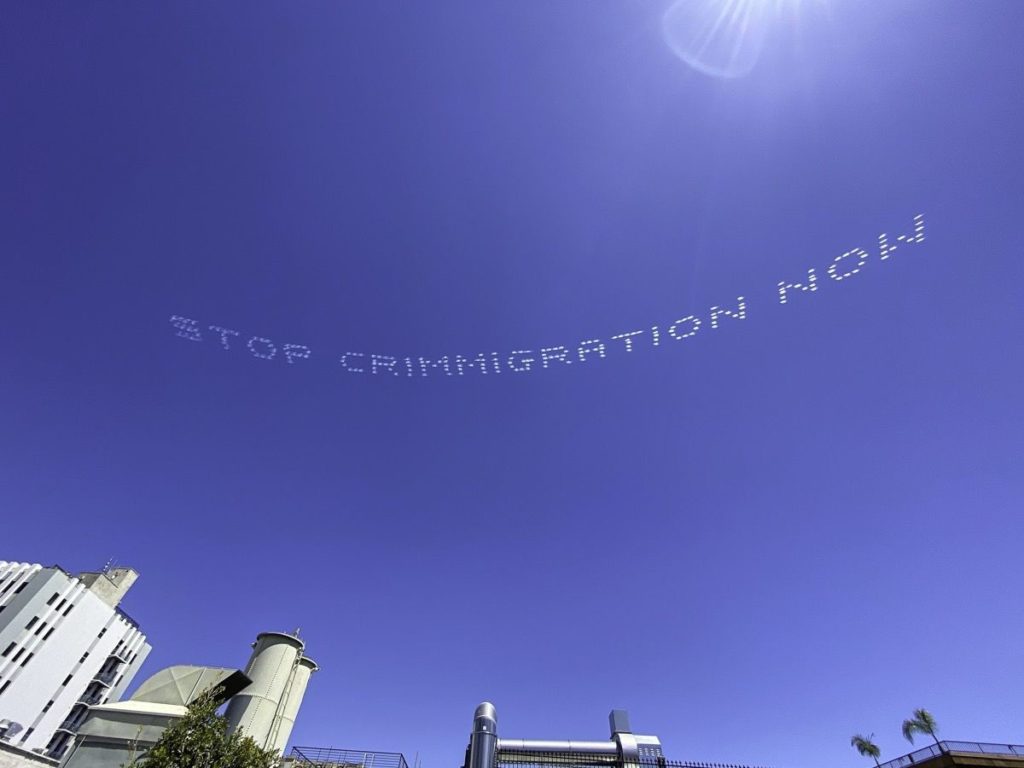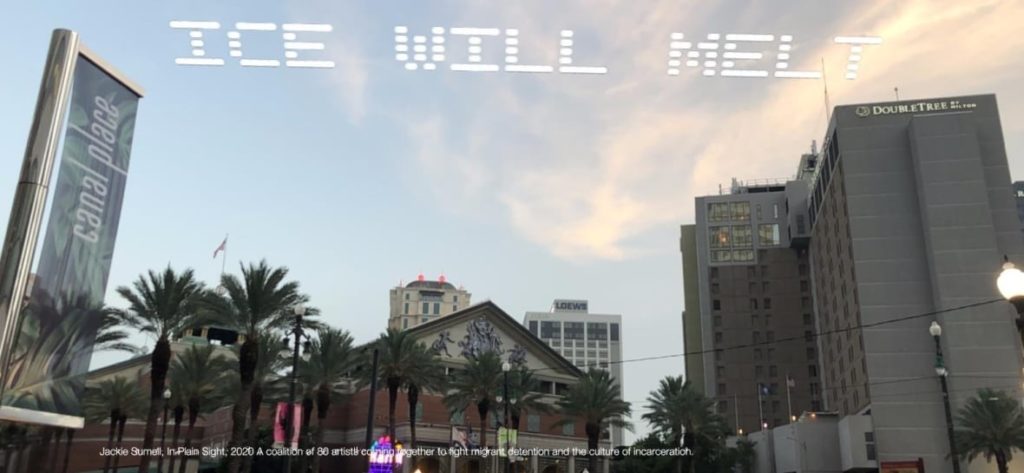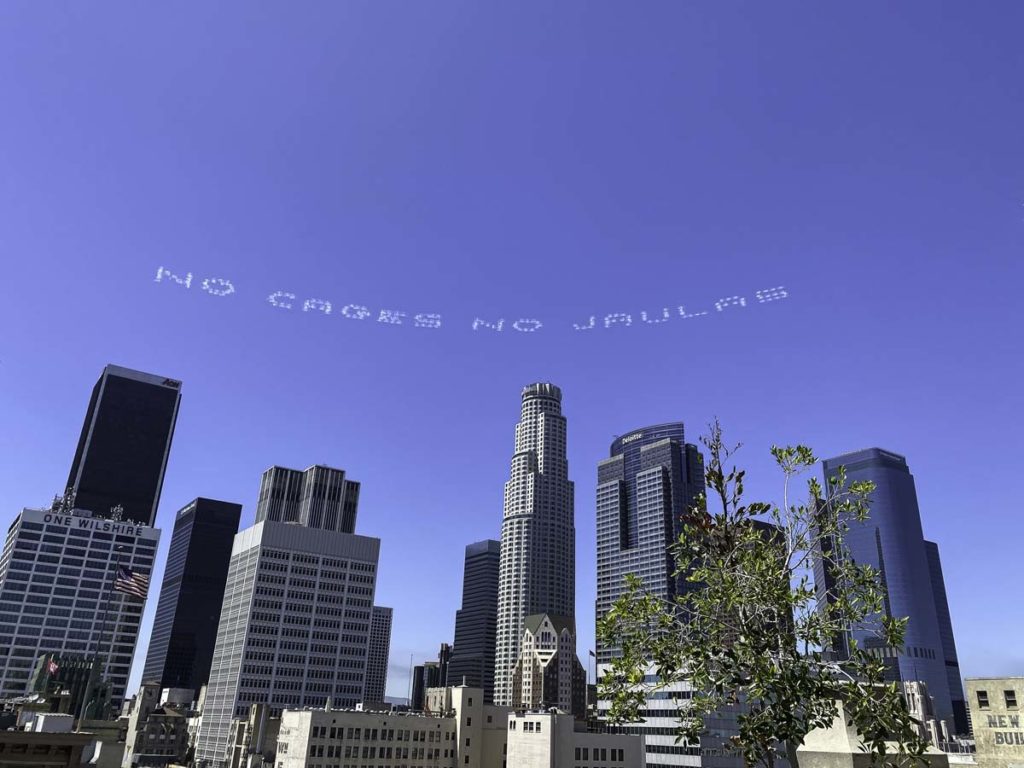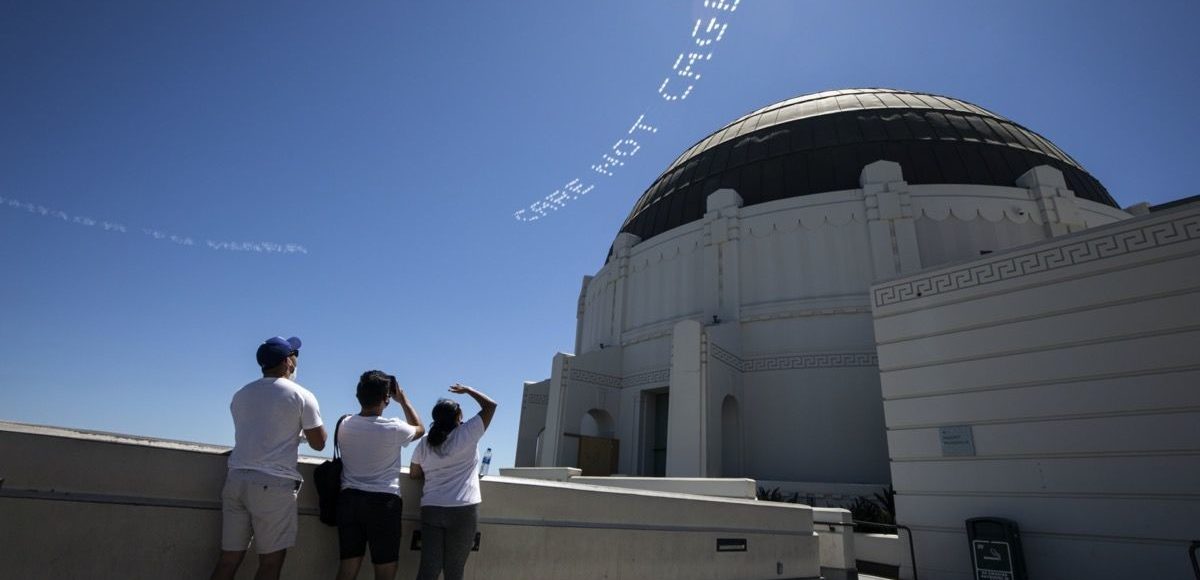CARE NOT CAGES. Artist: Patrisse Cullors, Co Founder of Black lives Matter, Los Angeles County Jail. Photo by: Chris Mastro. In Plain Sight, conceived by Cassils and rafa esparza, is a coalition of 80 artists fighting immigrant detention and the culture of incarceration. The performance occurred July, 2020. Image courtesy of In Plain Sight
On July 4th, there is nothing remarkable about skytyping … unless the planes type pro-immigrant messages in multiple languages and fly over detention centers. That’s remarkable.
This year, in eighty locations across the country, planes typed phrases like “CARE NOT CAGES” and “LA LUCHA LIVES.” They typed words of resistance, hope, and solidarity in twenty different languages. They typed #XMAP to direct viewers to the website of their art project, “In Plain Sight.”
In Plain Sight is an artist collective “dedicated to the abolition of immigrant detention and the United States culture of incarceration.”1 Founded by artists Cassils and rafa esperanzo, the collective dedicated a year to planning and fundraising. In an interview with the New York Times, Cassils describes the development of the idea: “Then, we thought about the air shows that typically happen on Independence Day. Was it possible to usurp this traditional display of patriotism and retool it to bring attention to harmful migration policies? There’s no censorship in the sky. It would be a perfect platform for mass engagement.”2
It was indeed a “perfect platform for mass engagement.” It was also an example of moral agency under constraint.
I define moral agency under constraint as claiming the creative power to act according to a perceived good under conditions that thwart its realization.
The mission statement, quoted above, names the goal (perceived good) of the project as “the abolition of detention and the United States culture of incarceration.” Patrisse Cullors, one of the contributors to In Plain Sight and a co-founder of Black Lives Matter, envisions “a world that prioritizes abolition. A world that imagines care and dignity and choice [as] our primary source of regeneration. A world that benefits all of us, not just the few. A world that denounced Cages.”3
Clearly, many powerful entities thwart the realization of this vision. ICE currently detains more than 50,000 people every day over a network of more than 200 detention centers, 80% of which are private.4 Trump’s family separation policy still keeps 4,368 children separated from their parents or guardians as of January 18, 2020.5 Moreover, detention is but one piece of a massive system of control and one expression of the carceral logic that dominates U.S. culture. Capitalism drives the privatization of prison and detention centers, and militarism arms police and security forces. White supremacy, colonization, and xenophobia motivate migration policies and practices. 6 As journalists report and In Plain Sight underscores, an interlocking system of structures, practices, and logics obstructs the good of a “world that denounces Cages.”

Image courtesy of In Plain Sight
In Plain Sight claims creative power to resist these systems of violence and proclaim an alternative vision. This project demonstrates moral agency not only in the typing, but also in the planning, networking, and fundraising that this particular exhibit required. Through interviews posted on Instagram and in brief bios on the #XMAP website, participating artists explain their choice of phrase and their reason for joining the project. They also document the ways in which the incarceration system constrains their art and advocacy, and they discuss the added constraint of COVID-19, which makes detention deadlier and public art and advocacy harder. Interviews and news stories explicitly name three constraints: the inherently violent nature of institutions in which they try to work for justice, the architecture of separation that obstructs care and communication, and the impact of COVID-19 on their work and collaboration.
Constraints, Creativity, and Communication
One member of the artist collective is Chase Strangio, an attorney and transgender rights activist who works with the American Civil Liberties Union. In an interview, Strangio reflected on his own experience as an attorney, explicitly using language of constraint: “As a lawyer, I am often constrained by the structural and discursive limits of the law.”7 In Plain Sight gave him an opportunity to act and speak in a very different mode. He chose to type “WE FIGHT 4 LORENA” over a U.S. Immigration Court in New York City. Lorena Borjas died of COVID-19 in early March, after devoting herself to justice work for trans members of the Latinx community. Explaining his decision to honor her, Strangio captures an example of moral agency under constraint, namely working for justice within systems that are violent.
“I choose to invoke her name and story to remind us as we engage with systems of law and the physical buildings in which legal decisions are made that ultimately the legal apparatus and our legal system are murderous. We may reform them and work within them at times for harm reduction but we must remember how dangerous they are. Lorena modeled what it looked like to build outside of and against the systems that she knew would kill her.”8
Strangio’s tribute describes moral agency under constraint in terms of pursuing a goal in and around, within and against institutions that simultaneously house and obstruct the work of justice.
Strangio conceived of his contribution as a remembrance and reminder, honoring someone and reminding his audience of the persistence of violence in institutions of justice. In the eighty statements from artists, it becomes clear that they intended the water vapor for many different audiences. They typed to those in power, those involved in ongoing work of justice-seeking, those standing by, and also — perhaps most poignantly — to those in detention. As noted in the write-up in the Los Angeles Times, In Plain Sight “was also about producing a work that could have briefly been visible to those who are incarcerated as well.”9 In his Instagram interview, Strangio described the powerful experience of “connecting with those human beings who we have caged in a shared message of … sort of … humanity.”10
Again, we see the work of moral agency under constraint: claiming creative power to pursue a perceived good (here connection and a humanizing message) within structures that thwart its realization.
Skytyping becomes moral agency as it expresses care and solidarity with those in isolation.
Guadalupe Rosales, another artist participant, works with digital and physical archives to tell the stories of marginalized and under-represented persons. It is fitting that she chose as her phrase “NO SON OLVIDADOS” or “They are not forgotten.” These words flew over Otay Mesa Detention Center in San Diego. Rosales said: “This is for those detained. I want them to know there are folks out here fighting for them and not giving up even if there are moments of silence. We are here.” 11 Skytyping to those in detention resists the constraints of isolation and separation built into the architecture of the carceral system.
For twenty years, Jackie Sumell has used art to connect with people in solitary confinement. Her project, Solitary Gardens, creates green spaces in communities on the outside designed by men and women in solitary confinement. She is practiced at maintaining connection even through the architecture of separation. In her Instagram interview, Sumell explains that she joined In Plain Sight because she perceived a “unique opportunity to bring together all of these really beautiful dreamers and thinkers and artists and activists who are organizing in our siloed spaces around — even if you are not calling abolition — around decarceration and around attacking the status quo’s complicity with systems of punishment and control.”12 Sumell chose to type “ICE WILL MELT” over the Field Office in New Orleans. She describes her phrase as “a call to arms, a promise, a commitment to entropy, change, and action.”13

Image courtesy of In Plain Sight
Like Rosales and Summel, artist Beatriz Cortez understands art to be a vehicle for connection and joined In Plain Sight to participate in collaboration for justice. Cortez describes art as inherently social: “creating is a thing that is about reaching out to others, forming communities, forming networks, forming multitudes, and it’s opposite of being paralyzed. And it’s beautiful.”14 COVID-19 has disrupted that kind of interaction and isolated her from others because she has been unable to continue working in her studio. In Plain Sight makes artist collaboration possible again.

As Cortez says, “it’s bringing together a network of artists across the country and allowing us to enter in conversation with each other to find spaces to come together and to get to know each other better and it’s also giving us the opportunity to…from many different perspectives and from diverse backgrounds to speak about the need to…talk about justice for immigrants.” Cortez contributed the phrase, “NO CAGES NO JUALAS,” which flew over the Immigration Court on Olive Street in Los Angeles. 15 An art project designed to resist the isolation of detention turned out to resist the isolation of the artist-activist as well. In contexts of separation, the collective claims the creative power of connection.
NO CAGES NO JUALAS. Artist: Beatriz Cortez, Immigration Court in Los Angeles. Photo by Dee Gonzales. In Plain Sight, conceived by Cassils and rafa esparza, is a coalition of 80 artists fighting immigrant detention and the culture of incarceration. The performance occurred July, 2020. Image courtesy of In Plain Sight
Messages Fade, but Resistance Remains
In Plain Sight uses distance to create connection. Speaking of the sky as the “ultimate platform,” rafa esperanzo describes the endeavor as “exiting the confines of traditional art spaces.”16 The viewer did not need to be proximate to observe the exhibit. As the press release promised, “these messages can be seen and read for miles.”17 The distance enabled communication at a time when COVID-19 closed exhibitions and complicated social protests. Over a few days, in eighty different locations, planes communicated resistance, remembrance, and solidarity. While fleeting, these messages pointed to an entrenched network of artists and activists on the ground. #XMAP continues the communication from and connection to organizations that document the violence of detention and incarceration, raise bond funds, advocate to abolish ICE, and mobilize voters. The messages also point to another time, to a “world that denounces Cages,” as Cullors says. In Plain Sight models moral agency under constraint by claiming a creative power to act according to a vision obstructed by interlocking structures of control and separation. In the presence of constraints on freedom, justice, activism, and art, skytyping with water vapor becomes moral agency. When the water vapor fades, the constraints remain. But so does the resistance.
Footnotes
- “In Plain Sight.” In Plain Sight Communications, 3 July 2020. Press release. https://xmap.us/assets/cms/xmap-in-plain-sight-press-release.pdf
- Small, Zachary. “Protesting U.S. Immigration Policies, Artists Aim for the Sky.” New York Times, 3 July 2020, https://www.nytimes.com/2020/07/03/arts/design/july-4-skytyping-skywriting-immigration.html. I should note that at least one artist did experience censorship when he proposed typing US KILLS US over the Statue of Liberty. According to artist Dread Scott, the New York skytyping company “refused to type this message.” You can read about Scott’s alternative message here: https://xmap.us/artists/dread-scott/.
- “Patrisse Cullors.” #XMAP In Plain Sight Artist Bios, https://xmap.us/artists/patrisse-cullors/.
- American Civil Liberties Union. “Justice-Free Zones: U.S. Immigration Detention under the Trump Administration.” April 2020, https://www.hrw.org/sites/default/files/supporting_resources/justice_free_zones_immigrant_detention.pdf.
- Southern Poverty Law Center, “Family Separation under the Trump Administration — A Timeline.” 18 January, 2020, https://www.splcenter.org/news/2020/06/17/family-separation-under-trump-administration-timeline#2020.
- “Solidarity Statement.” #XMAP Take Action, https://xmap.us/take-action.
- Small, https://www.nytimes.com/2020/07/03/arts/design/july-4-skytyping-skywriting-immigration.html.
- “Chase Strangio.” #XMAP In Plain Sight Artist Bios, https://xmap.us/artists/chase-strangio/.
- Miranda, Carolina A. “Did you see, up in the sky? 80 artists sent messages over U.S. detention centers.” Los Angeles Times, 3 July 2020, https://www.latimes.com/entertainment-arts/story/2020-07-03/july-4th-80-artists-sky-write-messages-over-detention-centers.
- inplainsightmap. “Chase Strangio.” Instagram, 28 May 2020, https://www.instagram.com/tv/CAv6DUPg13i/?utm_source=ig_web_copy_link.
- “Guadalupe Rosales.” #XMAP In Plain Sight Artist Bios, https://xmap.us/artists/guadalupe-rosales/.
- inplainsightmap. “Jackie Sumell.” Instagram, 19 April 2020, https://www.instagram.com/tv/B_Lxxdkl-FO/?utm_source=ig_web_copy_link.
- Jackie Summel.” #XMAP In Plain Sight Artist Bios, https://xmap.us/artists/jackie-sumell/.
- inplainsightmap. “Beatriz Cortez.” Instagram, 28 April 2020, https://www.instagram.com/tv/B_iazTWFKS6/.
- “Beatriz Cortez.” #XMAP In Plain Sight Artist Bios, https://xmap.us/artists/beatriz-cortez/.
- Miranda, https://www.latimes.com/entertainment-arts/story/2020-07-03/july-4th-80-artists-sky-write-messages-over-detention-centers.
- “In Plain Sight.” In Plain Sight Communications, 3 July 2020. Press release. https://xmap.us/assets/cms/xmap-in-plain-sight-press-release.pdf
